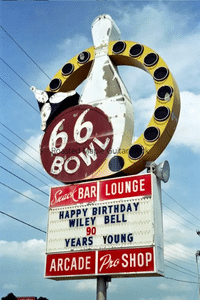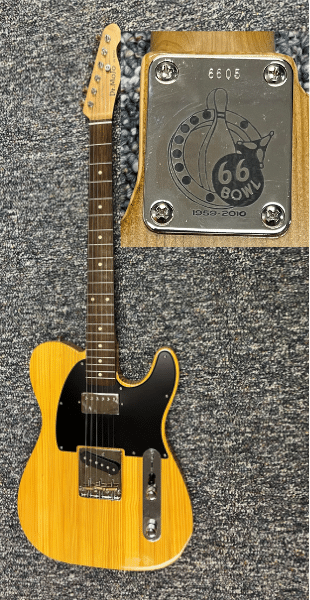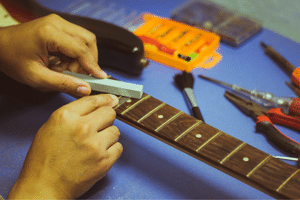So, what’s the deal with getting yourself a roasted maple guitar neck? It’s always something, and this is the latest craze in the electric guitar world. But is it just another gimmick or something to seriously consider? I wouldn’t blame you for being cautiously optimistic, and so was I.
However, I’ve had a Tele with a roasted maple neck for almost three years, and I love it! Keep on reading, and I’ll tell you why.
You can use the table of contents below to take you to the area that interests you. Click on the little box to open it and then click on the section of the article you want to read, or you can read from start to finish if you want the full roasted guitar neck experience!

What Is A Roasted Maple Guitar Neck?
A roasted maple guitar neck is, oddly enough, just what it sounds like.
Guitar manufacturers are cooking guitar necks in ovens (kilns)! This might sound crazy at first, but it is becoming an increasingly popular option, even among the big players, like Fender.
Roasting guitar necks is not an entirely new idea. Some boutique guitar makers have been doing it since the late 1980s and 90s.
Why Roast A Guitar Neck?
So, the obvious question is, why would you ever want to do that to a guitar neck?
Moisture, oils, sugars, and other impurities are removed from the wood during the roasting process. This mimics the natural aging process a guitar goes through over the years. As with vintage aging, roasting improves the tone of the wood.
Are Roasted Guitar Necks More Stable?
Yes, roasting makes the neck more stable, which means it stays in tune better with fewer intonation problems, especially in geographic areas with significant seasonal changes in temperature and humidity.
How Do You Roast A Maple Neck?
When a neck is roasted, the wood is placed in a special kiln, which heats it to over 300 degrees. During this time, the wood is slowly dried under strictly controlled conditions.
The process can take an entire day, although multiple neck blanks can be roasted simultaneously. During the roasting process, the wood temperature is increased very slowly and maintained constant, after which it is gradually cooled.
Each maple type (regular, flamed, bird’s eye, etc.) typically goes through a bit of a different roasting process regarding temperature and drying time.
The wood comes out of the kiln with varying degrees of “caramelization,” making the neck light, medium, or dark, depending on the wood’s sugar content.
Can You Roast Your Guitar’s Neck?
No, not unless you have the proper equipment and experience! You will definitely ruin it if you remove your guitar neck and try roasting it in the kitchen oven!
A guitar neck needs to be roasted in a special kiln under stringent temperature and humidity conditions and for a specific time.
The neck must be roasted before:
- A truss rod is installed
- Its fingerboard is glued on
- Frets and fret markers are installed
- The nut is glued in
- The wood is finished with any product like lacquer, urethane, or tung oil
In other words, the neck gets roasted as a wooden blank before anything else gets done.
Does A Roasted Neck Need To Be Finished
Technically speaking, a roasted neck does not need to be finished, but recommendations vary from one guitar maker to the next.
Some makers do not finish roasted wood. They claim it is not required and that the wood will not absorb moisture over the years. Warmoth does not recommend that their roasted necks be finished.
Fender commonly uses a gloss or satin urethane finish, and Kiesel finishes their roasted necks with a tung oil product. Other makers use a thin lacquer sealer.
The effect of not applying a finish remains to be seen since neck roasting is a relatively new process.
Cleaning A Roasted Maple Fretboard
Generally speaking, you can clean a Roasted Maple Neck And Fingerboard the same way you treat unroasted wood. Use an oil-based fretboard cleaner for unfinished fretboards. Finished maple can be cleaned with any standard (commonly available) fretboard cleaner.
However, it’s always best to check with the manufacturer of the neck or where you bought the guitar for specific instructions.
Can You Put A Fingerboard On A Roasted Maple Neck?
Yes, you can attach any type of fingerboard after the neck has been roasted, including rosewood, ebony, and Pau Ferro.
High-grade (AAA) roasted flamed maple necks look particularly spectacular and, therefore, are usually not covered with another tonewood for a fingerboard.
Using a roasted fingerboard will prevent “fret sprout” due to wood shrinkage over time, especially in rapidly changing climates. Fret sprout causes the fret ends to stick out past the fingerboard and make them feel rough as the player’s hand slides up and down the neck.
An unroasted fingerboard glued to a roasted neck does not make it less stable.

A Roasted Maple Neck
Where Can You Get A Roasted Maple Guitar Neck?
The easiest way to get a roasted maple neck is to buy a new guitar that has one preinstalled. This gives you the advantage of seeing how the neck looks, plays, and sounds with the guitar’s body and electronics.
Another option is to buy a ready-to-install replacement roasted maple neck for a guitar you already own. However, this can still require you to make modifications, like filing the nut slots and installing the tuning machines. Online guitar stores like Sweetwater and Guitar Center sell roasted necks separately.
If you want a custom-shaped neck, companies like Stewart-MacDonald (StewMac) sell roasted neck blanks, or you can make and roast your own neck, which I definitely would not recommend unless you have the proper experience and equipment.

Reasons To Get A Roasted Neck
Here are some reasons you might want to get a roasted neck. Also, see “Advantages Of Roasting” below.
- An unfinished roasted neck feels “smoother”
- Gives the wood a “relic’d” look
- Can choose the amount of “caramelization” (mild, medium, or dark)
- Makes high-grade (AAA) flamed maple look awesome
- Guitar resides in adverse climate conditions with frequent temperature and humidity changes
Keep On Reading To Learn More

Advantages Of Roasting
Also, check out “Reasons To Get A Roasted Neck” above.
- Improves tone of the wood (clearer and richer)
- Better tuning stability and intonation
- Makes the guitar lighter
- Increases sustain
- More warp resistant
- Prevents “fret sprout”

Disadvantages Of Roasting
Think about these points before committing to buy.
- Wood is a “caramel” color, which may be unattractive to some players
- Wood’s “bending strength” is decreased, and neck may become weaker over the years
- Makes the guitar neck more costly to the consumer
- Replacing the neck might decrease the guitar’s value
Roasting Vs Torrefaction Vs Pyrolysis
Although roasting, torrefaction (AKA torrefication), and pyrolysis are all similar processes, there is a lot of confusion about what they are and how they are used regarding guitar necks.
Roasting and Torrefication heat the wood to a lower temperature (200–300 °C) than Pyrolysis (350–700 °C). Pyrolysis is not used to treat maple guitar necks because the temperature exposure is too high.
Also, roasting occurs in a generally normal oxygen environment, so some “burning” may occur. Technically speaking, torrefaction and pyrolysis happen in a lower oxygen environment than roasting, so less burning can occur.
In the guitar industry, the terms roasting and torrefied have come to be used interchangeably.

Roasted Wood Can Be Delicate!
If you purchase a roasted maple guitar “blank” that needs to be finished, be aware that it is easier to “tear-out” or crack the wood during routing or drilling.
Be careful drilling things close together, like holes for tuning machines.
It takes a bit of woodworking experience to avoid a mishap.

Is A Roasted Maple Guitar Neck Worth It?
The answer generally depends on what you are looking for in a guitar neck and your particular situation.
Are you looking to replace the neck on a guitar you already own, or are you building a guitar? Do you live in a climate with abrupt temperature and humidity shifts? What is your budget for buying a guitar neck? Can you live with the darker appearance of a roasted neck?
The bottom line is that if you already have a guitar and the neck does not have any issues, such as tuning or intonation instability, I recommend you leave well enough alone. The guitar most likely requires an adjustment or setup to make it play and sound fine.
Also, you may not like the sound of your guitar as well once you replace the neck. Lastly, replacing the neck on an expensive or vintage guitar can drastically decrease its value, even if you keep the old one.
If you’re looking to build a guitar from scratch or assemble one from premade parts, I recommend you strongly consider getting a roasted neck. Before you commit, you may want to play a few guitars with roasted necks to see if you like the feel and sound.
My Experience With A Roasted Neck – The “66 Bowl” Guitar

I own one guitar with a roasted neck. It is a Tele made in a limited run of 20 guitars by Dr. Mojo to commemorate one of America’s most famous bowling alleys, “66 Bowl.”
66 Bowl opened in Oaklahoma on Route 66 in 1959 and closed in 2010 after multiple attempts to rescue it. Luckily, the local historical society salvaged its iconic roadside sign.

Roasted Maple Neck
Dr. Mojo Guitars bought the pine from the bowling alley lanes, which was used to fabricate the bodies of the 20 Telecasters. The first guitar went to Country picking legend Vince Gill. I ended up with the 5th one.
The neck has a beautiful medium-roasted look and feels great to the touch. I love the “smoothness” of the wood, which is distinctly different than an unroasted maple neck. It’s hard to explain, but it’s definitely noticeable!
The 21-fret fingerboard is made from unroasted rosewood, which is gorgeous and silky smooth. The frets are medium-jumbo with a 9 ½ inch fingerboard radius, which has been plek’d for maximum playability.
The guitar has Lollar pickups and sounds fabulous!
Over the past several years that I’ve had the guitar, living in the New England climate, the neck has not required any seasonal truss rod adjustments and the tuning and intonation are always “spot-on.”
When you play this guitar, it has a unique “good energy,” probably reminiscent of all the good times people had bowling at this fine establishment over the years.
If you’re in the market for a great Tele, check out my article on Player Plus Nashville Telecaster Review: The Best Tele Ever!

Are You Qualified To Make Guitar Adjustments Or Modifications?
It’s great to work on your guitars, especially if you have a lot of them, but you should always be aware of your limitations.
Adjusting things like an electric guitar’s string height (action) or pickup height can be straightforward. Still, some adjustments require the proper training and experience, like adjusting a guitar’s truss rod.
When you doubt your ability to adjust, repair, or modify your guitar, it’s always best to bring it to a competent guitar technician or luthier (guitar designer & builder). You can permanently damage your guitar, and it might never play and sound right again!
Making modifications to your guitar can void its manufacturer’s warranty and cause permanent damage to the instrument. Certain modifications are irreversible, so you may be stuck with them, even if you desperately want to restore the guitar to its original condition!
I learned that the hard way over the years until I did a three-year apprenticeship in a guitar repair shop. Now I have my own home workshop with the proper training and equipment to safely maintain and repair all my instruments.
Remember: “When In Doubt, Send It Out!”

Frequently Asked Questions
Here are some of the questions I get asked about roasted maple necks.
If your question does not appear here, please put it in the comments, and I will get right back to you with an answer.
Is Maple A Good Wood For A Guitar Neck?
Maple is an excellent hardwood for a guitar neck. It has been used over the years on guitars with great success. When fitted with a truss rod, it has excellent tuning stability.
An all maple neck and fretboard typically has a brighter tone with good sustain and a moderate weight.
Is Roasted Maple Stronger?
No, but this is still a matter of dispute among some guitar makers. The consensus of opinion seems to be that roasting a maple neck can make it weaker by decreasing the wood’s “bending strength” and that the neck may become more fragile over the years as the wood ages.
Do Roasted Maple Necks Warp?
Although the neck is not stronger, it is more stable and resists warping, especially during significant temperature and humidity changes.
Does A Roasted Maple Neck Have A Smell To It?
Yes, when the neck is initially roasted, it has a powerful smell that some players like and others do not, especially if you buy a roasted maple neck blank. With time the smell consistently decreases in intensity and then eventually disappears.
Don’t let the smell dissuade you from buying a guitar with a roasted neck.
What Is A Caramelized Maple Neck?
A caramelized maple neck is a neck that has been roasted. The degree of caramelization, determined by the sugar content (more sugar causes more caramelization), makes the neck take on a light, medium, or darker tint.

Final Thoughts
A roasted maple guitar neck is made from thermally modified wood that has been heated in a special kiln at a closely regulated temperature and humidity for a specific time period.
The roasting may appear to be light, medium, or dark. The final color depends on the type of maple (standard, birdseye, flamed, etc.) and the sugar content in the wood.
A roasted neck may be finished in various ways or left unfinished. They are most commonly finished with urethane or lacquer. Unfinished necks can be treated with tung oil of a similar product.
Roasted maple necks and fingerboards are cleaned the same way as unroasted necks. Any type of typical fingerboard wood can be used on a roasted neck.
You can buy a roasted neck factory installed on a guitar or purchase it separately and install it as an after-market product.
The main advantages of a roasted neck are tuning and intonation stability with improved tone and sustain. However, roasting can weaken the neck by decreasing its “bending strength.”
Roasted wood can be more challenging to work with because it is drier and more delicate to drill and route. Keep this in mind if you purchase a replacement electric guitar neck blank.

It’s best to get a roasted maple neck on a new guitar. It’s not necessary to replace the neck on a guitar unless there is a problem with the old one. Try getting it adjusted or have the entire guitar setup. You might not like the sound or playability of the new neck as much as the old one.

Tell Me What You Think
Please leave a comment below if you enjoyed this article, have any questions about a roasted maple guitar neck, or want to give your point of view. I will be happy to help you.
- Do you already own a guitar with a roasted maple neck? How do you like it?
- Are you thinking of replacing your guitar’s neck with one made from roasted maple? Why?
- What do you like best about roasted maple necks? Least?
- Have you heard about roasted maple necks before reading this article?



Hmm, this is interesting, but I think it’s because I assumed that guitar necks were treated in a kiln to create a more stable piece for a guitar. Good to know that it’s something special and that it could probably help keep the guitar in tune in the hot, humid summers. Is this something that is also used on bass guitars too?
Thanks for pointing out all the reasons that the method shouldn’t be tried at home! 🙂
Hi, Aly
Thank You for your comments!
Right you are! Some luthiers do very lightly dry their wood in a kiln before processing it, and other guitar makers air dry it naturally in a specially designed storage room.
Roasting a neck is a little different, and you can see it in the color of the wood.
Yes, there’s no reason you can’t roast a bass guitar neck. Fender makes a Jazz bass and Precision Bass roasted neck, and they are for sale at StewMac. Maybe you want to build yourself a bass guitar with a roasted neck? You can never have too many guitars! 😊
Frank 🎸
I was very curious to learn about what “roasted” meant?! I didn’t know you could roast wood so I was surprised. I think it is so cool and the advantages are worth considering getting one. Especially the fact that the guitar is more resistant to climate conditions and changes.Very interesting and informative article about roasted maple guitar neck. Thank you!
Hi There,
Thanks for checking out my article!
Now that you know a little about guitars, why not buy one and give it a try? You can pick up a beginner’s guitar for less than $200. Playing music is more fun than you can imagine and you don’t know what you’re missing! 😊
Frank 🎸
Looking for a roasted Strat neck with a variety of profiles to choose from.
Haven’t found ‘them’ yet.
Hi, Randolph
Thank You for your inquiry!
Your best bet for roasted maple Strat necks is the online music stores. Fender dot com (search roasted maple neck on their website) sells them. Sweetwater dot com has one of the better selections, and also check with guitar center and StewMac dot com.
Now’s a good time to grab one with the Black Friday sales!
Best,
Frank ?